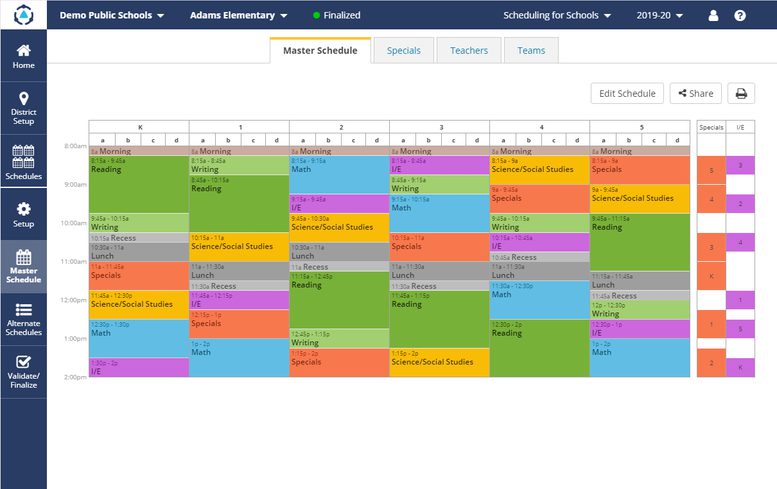This past spring, schools were faced with the challenge of quickly pivoting to a fully remote, distance learning environment with little time to prepare or transition. The rapidly changing context of the COVID-19 pandemic required continuous communication and collaboration among leadership, staff, students, families, and communities. As the 2020-2021 school year begins, we are anticipating that regardless of how school starts, there may be a need to quickly shift between different models pending local COVID-19 infection rates. Schools will likely have to transition through multiple schedules, including fully remote, hybrid, and fully in-person schedules. We’re sharing 5 key emerging practices to creating effective remote elementary schedules.
- Schedule dedicated time for targeted social-emotional supports, including a daily synchronous morning meeting block and short breaks for guided movement.
Social emotional well-being continues to be a top priority. When preparing remote schedule scenarios, consider adding breaks throughout the day. Scheduled and dedicated time for breaks and check-ins can help students focus and engage more fully during instructional or independent work time. Examples include, but are not limited to:
- Add a buffer time before synchronous/ “live” instructional blocks to help minimize technology delays during transitions
- Create a routine with dedicated blocks for movement to support the mental and physical health and well-being of students. Examples include:
- Provide families and caregivers with mindfulness tips
- Share activity, fitness, or movement videos
- Coordinate virtual “live” recesses with PE teachers or other school leaders
- Schedule 1:1 check-ins for the homeroom teacher to connect with each of their students to help build connections and check on student’s overall health and well-being
Schedule shorter instructional blocks with a focus on direct instruction in the morning and follow up with small group or independent practice in the afternoon
Remote schedules should consider and define developmentally appropriate durations for instruction. Attention spans and engagement for students working independently and primarily on computers will be different from those for students in a traditional classroom setting. When developing the schedule, consider shortening blocks and adding more breaks throughout the day to help students maintain focus and stay on task while remote.


Schedule common lunch/recess time across all grades and schools to provide additional collaboration opportunities for teachers
A key emerging practice for virtual schedules includes a shared, minimum of 1-hour (e.g. 12pm - 1pm), lunch and recess. Teachers, in addition to their lunch break, can leverage this shared time to check-in with other administrators, teachers, or students to prepare for the second half of the day. For schools implementing practice #2 above — providing a shorter than usual direct instructional block in the morning and an additional block in the afternoon for small group/independent work, a common mid-day break can serve as a time to troubleshoot any concerns, shift students into different small groups, and target any necessary remediation or enrichment in the latter half of the day.Consider a different approach to Specials (e.g. Art, Music, PE)
Many schools are also opting to shift how other instruction such as Specials occurs. In the spring, teachers and families felt that receiving multiple specials (Art, Music, PE) virtually each week was more challenging, requiring students to do a lot of juggling and transitioning. A single homeroom could receive the same special for an extended duration (week(s)) and then rotate to the next special. This may vary based on the number of specials available in your building. A common specials rotation is 6-weeks, but quarterly rotation or trimester rotation may also be applicable. This can help students engage with the content on a deeper level, support student and teacher “pods” with fewer interactions, ease staffing demands, and simplify grading.Set clear schedule expectations for families and students and foster open communication and flexibility to efficiently adapt as needs and circumstances change
Clear and consistent communication can build your communities confidence, reduce concerns, and help set expectations. This holds true for shifts in schedules and scheduling practices. These difficult times require schools to manage and move between multiple schedules throughout the year. Effective communication will ease schedule transitions and reduce the hours you and your staff spend responding to questions and concerns.- Provide information at regular intervals (e.g. weekly, biweekly) so families and caregivers understand the tempo of communication.
- Share the resources available for families and students in every communication (e.g. Student assignment pages; COVID policy location, remote student support FAQs, etc.)
- Outline any changes in learning modality, duration, breaks etc. to set expectations (e.g. synchronous vs. asynchronous instruction, check-in points for parents)
- Prior to implementing schedule changes, send parent/guardian communication and request acknowledgment (e.g. teacher communicates to parents and requests digital confirmation)
- Clearly identify tools (e.g. survey, feedback channels) to efficiently centralize, review, and troubleshoot concerns
As circumstances demand schedule changes (e.g. transition from remote to hybrid), it is important to:
Adjusting to a remote model is challenging for students, teachers, parents, and administrators alike. But emerging practices such as these are helping to make remote learning and remote teaching more effective and more manageable. DMGroup and our DMSchedules team work with hundreds of schools across the country and seek to share the best emerging practices that we encounter. Do you have virtual practices that are working well in your elementary school? Email us using scheduling@dmgroupK12.com to share.
If you want to explore any of these ideas further or see how DMSchedules can help you put these practices into action, contact us at scheduling@dmgroupk12.com or visit us at dmschedules.com.

About DMSchedules
Create Better School and Staff Schedules Now with DMGroup’s DMSchedules Scheduling Software
Learn more

